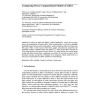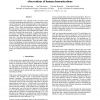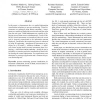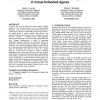202 search results - page 20 / 41 » Modeling collision avoidance behavior for virtual humans |
PAAMS
2010
Springer
14 years 15 days ago
2010
Springer
In aiming for behavioral fidelity, artificial intelligence cannot and no longer ignores the formalization of human affect. Affect modeling plays a vital role in faithfully simulati...
CA
2000
IEEE
14 years 4 days ago
2000
IEEE
Hair-to-hair interaction is often ignored in human hair modeling, due to its computational and algorithmic complexity. In this paper, we present our experimental approach to simul...
ICRA
2002
IEEE
14 years 20 days ago
2002
IEEE
This paper describes a new approach on how to teach a robot everyday manipulation tasks under the “Learning from Observation” framework. Most of the approaches so far assume t...
INFOVIS
2002
IEEE
14 years 20 days ago
2002
IEEE
In this paper we demonstrate how we applied information visualization techniques to process monitoring. Virtual instruments are enhanced using history encoding – instruments are...
ATAL
2008
Springer
13 years 9 months ago
2008
Springer
Currently, state of the art virtual agents lack the ability to display emotion as seen in actual humans, or even in hand-animated characters. One reason for the emotional inexpres...




